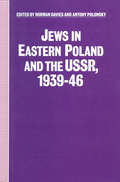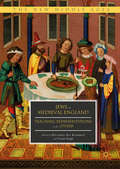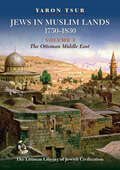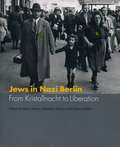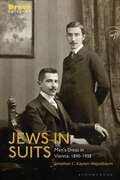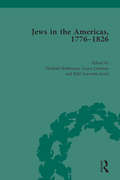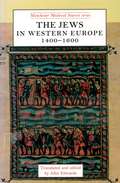- Table View
- List View
Jews in Eastern Poland and the USSR, 1939-46 (Studies in Russia and East Europe)
by Norman Davies Antony PolonskyThis book is the first to deal with the impact on the Jews of the area of the sovietization of Eastern Poland. Polish resentment at alleged Jewish collaboration with the Soviets between 1939 and 1941 affected the development of Polish-Jewish relations under Nazi rule and in the USSR. The role of these conflicts both in the Anders army and in the Communist-led Kosciuszko division and 1st Polish Army is investigated, as well as the part played by Jews in the communist-dominated regime in Poland after 1944.
Jews in Italy under Fascist and Nazi Rule, 1922-1945 (PDF)
by Joshua ZimmermanJews in Italy under Fascist and Nazi Rule, 1922-1945, brings to light the Italian-Jewish experience from the start of Mussolini's prime ministership through the end of the Second World War. Challenging the myth of Italian benevolence during the Fascist period, the authors investigate the treatment of Jews by Italians during the Holocaust and the native versus foreign roots of Italian Fascist anti-Semitism. Each essay in this volume illustrates a different aspect of Italian Jewry under Fascist and Nazi rule. Areas of inquiry include the role of the Catholic Church with special reference to Pope Pius XII, Mussolini's attitude, and anti-Jewish persecution. Included also is an examination of cover images and articles from the Italian racist newspaper, La Difesa della Razza, intended to lay bare the influence of the Italian media on the general Italian public.
Jews in Medieval England: Teaching Representations of the Other
by Miriamne Ara Krummel Tison PughThis volume examines the teaching of Jewishness within the context of medieval England. It covers a wide array of academic disciplines and addresses a multitude of primary sources, including medieval English manuscripts, law codes, philosophy, art, and literature, in explicating how the Jew-as-Other was formed. Chapters are devoted to the teaching of the complexities of medieval Jewish experiences in the modern classroom. Jews in Medieval England: Teaching Representations of the Other also grounds medieval conceptions of the Other within the contemporary world where we continue to confront the problematic attitudes directed toward alleged social outcasts.
Jews in Medieval England: Teaching Representations of the Other
by Miriamne Ara Krummel Tison PughThis volume examines the teaching of Jewishness within the context of medieval England. It covers a wide array of academic disciplines and addresses a multitude of primary sources, including medieval English manuscripts, law codes, philosophy, art, and literature, in explicating how the Jew-as-Other was formed. Chapters are devoted to the teaching of the complexities of medieval Jewish experiences in the modern classroom. Jews in Medieval England: Teaching Representations of the Other also grounds medieval conceptions of the Other within the contemporary world where we continue to confront the problematic attitudes directed toward alleged social outcasts.
Jews in Muslim Lands, 1750–1830: Volume I: The Ottoman Middle East (The Littman Library of Jewish Civilization)
by Yaron TsurThis fascinating tour of the Jewish communities of the Ottoman Middle East, on the eve of the changes that would come to unsettle the Ottoman territories, reveals a surprisingly varied world. Visiting Istanbul, Damascus, Acre, Jerusalem, Aleppo, Basra, and Cairo, we see different landscapes, meet diverse Jewish societies, and encounter the range of their economic activities. We also see how Christians and Jews struggled with each other to establish their position in the Muslim world and secure their livelihood. In the process, the author reconsiders fundamental questions. What is a ‘diaspora’? To what extent did the surrounding culture impact the Jewish communities of the area? And, most interestingly, how did these communities respond to the onset of modernity? Though relating to Jewish society in its entirety, the main focus is on its most powerful members: the notables, who were close to the ruling elite or involved in international trade. Tsur discusses their strengths and weaknesses, considers the relationship between their position and that of the rest of the Jewish community, and analyses their eventual downfall. His study offers new insights into the social mechanisms that enabled them to establish close ties with the ruling elite and to function within it.
Jews in Muslim Lands, 1750–1830: Volume I: The Ottoman Middle East (The Littman Library of Jewish Civilization)
by Yaron TsurThis fascinating tour of the Jewish communities of the Ottoman Middle East, on the eve of the changes that would come to unsettle the Ottoman territories, reveals a surprisingly varied world. Visiting Istanbul, Damascus, Acre, Jerusalem, Aleppo, Basra, and Cairo, we see different landscapes, meet diverse Jewish societies, and encounter the range of their economic activities. We also see how Christians and Jews struggled with each other to establish their position in the Muslim world and secure their livelihood. In the process, the author reconsiders fundamental questions. What is a ‘diaspora’? To what extent did the surrounding culture impact the Jewish communities of the area? And, most interestingly, how did these communities respond to the onset of modernity? Though relating to Jewish society in its entirety, the main focus is on its most powerful members: the notables, who were close to the ruling elite or involved in international trade. Tsur discusses their strengths and weaknesses, considers the relationship between their position and that of the rest of the Jewish community, and analyses their eventual downfall. His study offers new insights into the social mechanisms that enabled them to establish close ties with the ruling elite and to function within it.
Jews in Nazi Berlin: From Kristallnacht to Liberation (Studies in German-Jewish Cultural History and Literature, Franz Rosenzweig Minerva Research Center, Hebrew University of Jerusalem)
by Beate Meyer Hermann Simon Chana SchützThough many of the details of Jewish life under Hitler are familiar, historical accounts rarely afford us a real sense of what it was like for Jews and their families to live in the shadow of Nazi Germany’s oppressive racial laws and growing violence. With Jews in Nazi Berlin, those individual lives—and the constant struggle they required—come fully into focus, and the result is an unprecedented and deeply moving portrait of a people. Drawing on a remarkably rich archive that includes photographs, objects, official documents, and personal papers, the editors of Jews in Nazi Berlin have assembled a multifaceted picture of Jewish daily life in the Nazi capital during the height of the regime’s power. The book’s essays and images are divided into thematic sections, each representing a different aspect of the experience of Jews in Berlin, covering such topics as emigration, the yellow star, Zionism, deportation, betrayal, survival, and more. To supplement—and, importantly, to humanize—the comprehensive documentary evidence, the editors draw on an extensive series of interviews with survivors of the Nazi persecution, who present gripping first-person accounts of the innovation, subterfuge, resilience, and luck required to negotiate the increasing brutality of the regime. A stunning reconstruction of a storied community as it faced destruction, Jews in Nazi Berlin renders that loss with a startling immediacy that will make it an essential part of our continuing attempts to understand World War II and the Holocaust.
Jews in Nazi Berlin: From Kristallnacht to Liberation (Studies in German-Jewish Cultural History and Literature, Franz Rosenzweig Minerva Research Center, Hebrew University of Jerusalem)
by Beate Meyer Hermann Simon Chana C. SchützThough many of the details of Jewish life under Hitler are familiar, historical accounts rarely afford us a real sense of what it was like for Jews and their families to live in the shadow of Nazi Germany’s oppressive racial laws and growing violence. With Jews in Nazi Berlin, those individual lives—and the constant struggle they required—come fully into focus, and the result is an unprecedented and deeply moving portrait of a people. Drawing on a remarkably rich archive that includes photographs, objects, official documents, and personal papers, the editors of Jews in Nazi Berlin have assembled a multifaceted picture of Jewish daily life in the Nazi capital during the height of the regime’s power. The book’s essays and images are divided into thematic sections, each representing a different aspect of the experience of Jews in Berlin, covering such topics as emigration, the yellow star, Zionism, deportation, betrayal, survival, and more. To supplement—and, importantly, to humanize—the comprehensive documentary evidence, the editors draw on an extensive series of interviews with survivors of the Nazi persecution, who present gripping first-person accounts of the innovation, subterfuge, resilience, and luck required to negotiate the increasing brutality of the regime. A stunning reconstruction of a storied community as it faced destruction, Jews in Nazi Berlin renders that loss with a startling immediacy that will make it an essential part of our continuing attempts to understand World War II and the Holocaust.
Jews in Nineteenth-Century Britain: Charity, Community and Religion, 1830-1880
by Alysa LeveneThis book examines Jewish communities in Britain in an era of immense social, economic and religious change: from the acceleration of industrialisation to the end of the first phase of large-scale Jewish immigration from Europe. Using the 1851 census alongside extensive charity and community records, Jews in Nineteenth-Century Britain tests the impact of migration, new types of working and changes in patterns of worship on the family and community life of seven of the fastest-growing industrial towns in Britain. Communal life for the Jews living there (over a third of whom had been born overseas) was a constantly shifting balance between the generation of wealth and respectability, and the risks of inundation by poor newcomers. But while earlier studies have used this balance as a backdrop for the story of individual Jewish communities, this book highlights the interactions between the people who made them up. At the core of the book is the question of what membership of the 'imagined community' of global Jewry meant: how it helped those who belonged to it, how it affected where they lived and who they lived with, the jobs that they did and the wealth or charity that they had access to. By stitching together patterns of residence, charity and worship, Alysa Levene is here able to reveal that religious and cultural bonds had vital functions both for making ends meet and for the formation of identity in a period of rapid demographic, religious and cultural change.
Jews in Nineteenth-Century Britain: Charity, Community and Religion, 1830-1880
by Alysa LeveneThis book examines Jewish communities in Britain in an era of immense social, economic and religious change: from the acceleration of industrialisation to the end of the first phase of large-scale Jewish immigration from Europe. Using the 1851 census alongside extensive charity and community records, Jews in Nineteenth-Century Britain tests the impact of migration, new types of working and changes in patterns of worship on the family and community life of seven of the fastest-growing industrial towns in Britain. Communal life for the Jews living there (over a third of whom had been born overseas) was a constantly shifting balance between the generation of wealth and respectability, and the risks of inundation by poor newcomers. But while earlier studies have used this balance as a backdrop for the story of individual Jewish communities, this book highlights the interactions between the people who made them up. At the core of the book is the question of what membership of the 'imagined community' of global Jewry meant: how it helped those who belonged to it, how it affected where they lived and who they lived with, the jobs that they did and the wealth or charity that they had access to. By stitching together patterns of residence, charity and worship, Alysa Levene is here able to reveal that religious and cultural bonds had vital functions both for making ends meet and for the formation of identity in a period of rapid demographic, religious and cultural change.
The Jews in Poland and Russia: Volume II: 1881 to 1914 (The Littman Library of Jewish Civilization)
by Antony PolonskyIn his three-volume history, Antony Polonsky provides a comprehensive survey—socio-political, economic, and religious—of the Jewish communities of eastern Europe from 1350 to the present. Until the Second World War, this was the heartland of the Jewish world: nearly three and a half million Jews lived in Poland alone, while nearly three million more lived in the Soviet Union. Although the majority of the Jews of Europe and the United States, and many of the Jews of Israel, originate from these lands, their history there is not well known. Rather, it is the subject of mythologizing and stereotypes that fail both to bring out the specific features of the Jewish civilization which emerged there and to illustrate what was lost. Jewish life, though often poor materially, was marked by a high degree of spiritual and ideological intensity and creativity. Antony Polonsky recreates this lost world—brutally cut down by the Holocaust and less brutally but still seriously damaged by the Soviet attempt to destroy Jewish culture. Wherever possible, the unfolding of history is illustrated by contemporary Jewish writings to show how Jews felt and reacted to the complex and difficult situations in which they found themselves. This second volume covers the period from 1881 to 1914. It considers the deterioration of the position of the Jews during that period and the new political and cultural movements that developed as a consequence: Zionism, socialism, autonomism, the emergence of modern Hebrew and Yiddish literature, Jewish urbanization, and the rise of popular Jewish culture. Galicia, Prussian Poland, the Kingdom of Poland, and the Tsarist Empire are all treated individually, as are the main towns of these areas. Volume 1 covers the period 1350–1881; Volume 3 covers 1914–2008.
The Jews in Poland and Russia: Volume I: 1350 to 1881 (The Littman Library of Jewish Civilization)
by Antony PolonskyIn his three-volume history, Antony Polonsky provides a comprehensive survey—socio-political, economic, and religious—of the Jewish communities of eastern Europe from 1350 to the present. Until the Second World War, this was the heartland of the Jewish world: nearly three and a half million Jews lived in Poland alone, while nearly three million more lived in the Soviet Union. Although the majority of the Jews of Europe and the United States, and many of the Jews of Israel, originate from these lands, their history there is not well known. Rather, it is the subject of mythologizing and stereotypes that fail both to bring out the specific features of the Jewish civilization which emerged there and to illustrate what was lost. Jewish life, though often poor materially, was marked by a high degree of spiritual and ideological intensity and creativity. Antony Polonsky recreates this lost world—brutally cut down by the Holocaust and less brutally but still seriously damaged by the Soviet attempt to destroy Jewish culture. Wherever possible, the unfolding of history is illustrated by contemporary Jewish writings to show how Jews felt and reacted to the complex and difficult situations in which they found themselves. This first volume begins with an overview of Jewish life in Poland and Lithuania down to the mid-eighteenth century. It describes the towns and shtetls where the Jews lived, the institutions they developed, and their participation in the economy. Developments in religious life, including the emergence of hasidism and the growth of opposition to it, are described in detail. The volume goes on to cover the period from 1764 to 1881, highlighting government attempts to increase the integration of Jews into the wider society and the Jewish responses to these efforts, including the beginnings of the Haskalah movement. Attention is focused on developments in each country in turn: the problems of emancipation, acculturation, and assimilation in Prussian and Austrian Poland; the politics of integration in the Kingdom of Poland; and the failure of forced integration in the tsarist empire. Volume 2 covers the period 1881–1914; Volume 3 covers 1914–2008.
The Jews in Poland and Russia: Volume III: 1914 to 2008 (The Littman Library of Jewish Civilization)
by Antony PolonskyAntony Polonsky provides a comprehensive survey of the history - socio-political, economic, and religious - of the Jewish communities of eastern Europe from 1750, when the Polish - Lithuanian Commonwealth was the dominant political unit, to the present. Until the Second World War, this area was the heartland of the Jewish world: almost all the major movements which have characterized that world in recent times had their origins here, and it was home to the majority of the world's Jews. Nearly three and a half million lived in Poland alone, while nearly three million more lived in the Soviet Union. Although the majority of the Jews of Europe and the United States, and most of the Jews of Israel, originated from these lands, the history of their Jewish communities is not well known. Rather, it is the subject of mythologizing and stereotypes that fail both to bring out the specific features of the Jewish civilization which emerged here and to illustrate what was lost in the passage across the Channel and the Atlantic. Jewish life in these parts, though often poor materially, was marked by a high degree of spiritual and ideological intensity and creativity. Antony Polonsky recreates this lost world - brutally cut down by the Holocaust and less brutally but still seriously damaged by the Soviet attempt to destroy Jewish culture - in a way that avoids both sentimentalism and the simplification of the the east European Jewish experience into a story of persecution and martyrdom. Wherever possible, the unfolding of history is illustrated by contemporary Jewish writings to show how Jews felt and reacted to the complex and difficult situations in which they found themselves. It is an important story whose relevance reaches far beyond the Jewish world or the bounds of east-central Europe. Polonsky establishes the context with a review of Jewish life in Poland and Lithuania down to the mid-eighteenth century, describing the towns and shtetls where the Jews lived, the institutions they developed, and their participation in the economy. He also considers their religious and intellectual life, including the emergence of hasidism, and the growth of opposition to it. He then describes government attempts to integrate and transform the Jews in the period from 1764 to 1881 and the Jewish response to these efforts. He considers the impact of modernization and the beginnings of the Haskalah movement, and looks at developments in each area in turn: the problems of emancipation, acculturation, and assimilation in Prussian and Austrian Poland; the politics of integration in the Kingdom of Poland; and the failure of forced integration in the tsarist empire. The third part of the book considers the deterioration of the position of the Jews in the period from 1881 to 1914 and the new Jewish politics that led to the development of new movements: Zionism, socialism, autonomism, the emergence of modern Hebrew and Yiddish literature, Jewish urbanization, and the rise of Jewish mass culture. Galicia, Prussian Poland, the Kingdom of Poland, and the tsarist empire are all treated individually, as are the main towns. The final part deals with the twentieth century. Starting from the First World War and the establishment of the Soviet Union, it deals in turn with Poland, Lithuania, and the Soviet Union up to the Second World War. It then reviews Polish - Jewish relations during the Second World War and examines the Soviet record and the Holocaust. The final chapters deal with the Jews in the Soviet Union and in Poland since 1945, concluding with an epilogue on the Jews in Poland, Lithuania, Belarus, Ukraine, and Russia since the collapse of communism.
The Jews in Poland and Russia: A Short History (The Littman Library of Jewish Civilization)
by Antony PolonskyFor many centuries Poland and Russia formed the heartland of the Jewish world: right up to the Second World War the area was home to over 40 per cent of the world's Jews. Nearly three and a half million Jews lived in Poland alone, with nearly three million more in the Soviet Union. Yet although the majority of the Jews of Europe and the United States, and a large proportion of the Jews of Israel, originate from these lands, and many of the major movements that have characterized the Jewish world in recent times have their origins there, the history of their Jewish communities is not well known. Rather, it is the subject of mythologizing that fails both to bring out the specific features of the Jewish civilization that emerged there and to illustrate what was lost in its destruction: Jewish life in these parts, though often poor materially, was marked by a high degree of spiritual and ideological intensity and creativity. Antony Polonsky re-creates this lost world - brutally cut down by the Holocaust and seriously damaged by the Soviet attempt to destroy Jewish culture - in a study that avoids both sentimentalism and the simplification of the east European Jewish experience into a story of persecution and martyrdom. It is an important story whose relevance reaches far beyond the Jewish world or the bounds of east-central Europe, and Professor Polonsky succeeds in providing a comprehensive overview that highlights the realities of Jewish life while also setting them in the context of the political, economic, and social realities of the time. He describes not only the towns and shtetls where the Jews lived, the institutions they developed, and their participation in the economy, but also their vibrant religious and intellectual life, including the emergence of hasidism and the growth of opposition to it from within the Jewish world. By the late eighteenth century other factors had come into play: with the onset of modernization there were government attempts to integrate and transform the Jews, and the stirrings of Enlightenment led to the growth of the Haskalah movement that was to revolutionize the Jewish world. Polonsky looks at developments in each area in turn: the problems of emancipation, acculturation, and assimilation in Prussian and Austrian Poland; the politics of integration in the Kingdom of Poland; and the failure of forced integration in the tsarist empire. He then shows how the deterioration in the position of the Jews between 1881 and 1914 encouraged a range of new movements - Zionism, socialism, and autonomism - as well as the emergence of modern Hebrew and Yiddish literature. He also examines Jewish urbanization and the rise of Jewish mass culture. The final part of the volume deals with the twentieth century. Starting from the First World War and the establishment of the Soviet Union, it looks in turn at Poland, Lithuania, and the Soviet Union up to the Second World War. It then reviews Polish - Jewish relations during the war and examines the Soviet record in relation to the Holocaust. The final chapters deal with the Jews in the Soviet Union and in Poland since 1945, concluding with an epilogue on the Jews in Poland, Lithuania, Belarus, Ukraine, and Russia since the collapse of communism. This is an abridged version of a three-volume hardback edition which won the 2011 Kulczycki Book Prize for Polish Studies (awarded by the American Association for Slavic, East European, and Eurasian Studies) and also the Pro Historia Polonorum Prize for the best book on the history of Poland published in a foreign language between 2007 and 2011 (a prize established by the Polish Senate and awarded by the Polish Historical Association).
Jews In The Roman World
by Michael GrantIn describing the triangular relationship among the Jews, the Romans and the Greeks, Michael Grant treats one of the most significant themes in world history.Unlike almost all the other subject nations of the Roman empire, the Jews have survived and have maintained a religious and cultural identity that is substantially unchanged. They provide a unique bridge with the ancient world and can bring us into peculiarly close and intimate contact with life in the Roman empire.This book embraces the period in which the Jewish religion assumed virtually its final form, and in which Jews launched their two heroic, but disastrous revolts against Roman rule. This was, moreover, the time when Judaism gave birth to Christianity. Within a century after the death of Jesus, his followers had become completely independent of Judaism. Michael Grant describes the grandeur of the great multiracial Roman empire, beneath whose rule these stirring and unique developments took place.
Jews in Suits: Men's Dress in Vienna, 1890-1938 (Dress Cultures)
by Jonathan C. Kaplan-WajselbaumSurviving photographs of Jewish Viennese men during the fin-de-siècle and interwar periods – both the renowned cultural luminaries and their many anonymous coreligionists – all share a striking sartorial detail: the tailored suit. Yet, until now, the adoption of the tailored suit and its function in the formation of modern Jewish identities remains under-researched.Jews in Suits uses a rich range of written and visual sources, including literary fiction and satire, 'ego-documents', photography, trade catalogues, invoices, and department store culture, to propose a new narrative of men, fashion, and their Jewish identities. It reveals that dressing in a modern manner was not simply a matter of assimilation, but rather a way of developing new models of Jewish subjectivity beyond the externally prescribed notion of 'the Jew'. Drawing upon fashionable dress, folk costume, religious dress, avant-garde, oppositional dress, typologies which are often considered separate from one another, it proposes a new way of reading men and clothing cultures within an iconic cultural milieu, offering insights into the relationship of clothing and grooming to the understanding of the self.
Jews in Suits: Men's Dress in Vienna, 1890-1938 (Dress Cultures)
by Jonathan C. Kaplan-WajselbaumSurviving photographs of Jewish Viennese men during the fin-de-siècle and interwar periods – both the renowned cultural luminaries and their many anonymous coreligionists – all share a striking sartorial detail: the tailored suit. Yet, until now, the adoption of the tailored suit and its function in the formation of modern Jewish identities remains under-researched.Jews in Suits uses a rich range of written and visual sources, including literary fiction and satire, 'ego-documents', photography, trade catalogues, invoices, and department store culture, to propose a new narrative of men, fashion, and their Jewish identities. It reveals that dressing in a modern manner was not simply a matter of assimilation, but rather a way of developing new models of Jewish subjectivity beyond the externally prescribed notion of 'the Jew'. Drawing upon fashionable dress, folk costume, religious dress, avant-garde, oppositional dress, typologies which are often considered separate from one another, it proposes a new way of reading men and clothing cultures within an iconic cultural milieu, offering insights into the relationship of clothing and grooming to the understanding of the self.
Jews in the Americas, 1776-1826 (Routledge Historical Resources)
by Michael Hoberman Laura Leibman Hilit Surowitz-IsraelThe period between 1776-1826 signalled a major change in how Jewish identity was understood both by Jews and non-Jews throughout the Americas. Jews in the Americas, 1776-1826 brings this world of change to life by uniting important out-of-print primary sources on early American Jewish life with rare archival materials that can currently be found only in special collections in Europe, England, the United States, and the Caribbean.
Jews in the Americas, 1776-1826 (Routledge Historical Resources)
by Michael Hoberman Laura Leibman Hilit Surowitz-IsraelThe period between 1776-1826 signalled a major change in how Jewish identity was understood both by Jews and non-Jews throughout the Americas. Jews in the Americas, 1776-1826 brings this world of change to life by uniting important out-of-print primary sources on early American Jewish life with rare archival materials that can currently be found only in special collections in Europe, England, the United States, and the Caribbean.
The Jews in the Caribbean (The Littman Library of Jewish Civilization)
The Portuguese Jewish diaspora was born out of a double tragedy: the expulsion of the Jews from Spain in 1492 and the forced conversion/expulsion of the Jews from Portugal in 1497. The potent combination of expulsion, Inquisition, and crypto-Judaism left people neither wholly Jewish nor wholly Christian in their identity. Subsequently many left the Iberian peninsula; some found refuge in the Caribbean, but succeeded in maintaining strong connections with Portuguese Jews in western Europe, the Ottoman empire, and the Far East, while they also forged ties with the surrounding peoples and cultures. This book looks at many different aspects of this complex past. Its interdisciplinary approach allows a wealth of new information to be brought together to create a comprehensive picture. Part I sets the context, and also considers the relationship of Caribbean Jewry to European trading systems; its special ties to Amsterdam and Dutch-ruled Curaçao; and the role of Jewish merchants in Jamaica’s commerce. Part II examines the material and visual culture of Jews in the British and Dutch Caribbean, while Part III looks at Caribbean Jewish identity and heritage and their modern manifestations. Part IV contains archival studies that illuminate other subjects of importance—adventure and piracy, Jewish participation in a nineteenth-century revolt of black slaves and in the first Jamaican elections after Jews were granted the right to vote, and questions of concubinage and sexual relations between Jews and blacks. Part V moves from the local to the international, in particular the connection with mainland America. In their diversity, the contributions to this volume suggest the many ways in which the formation of the Caribbean Jewish diaspora can be understood today: as a Jewish diaspora dispersed under different European colonial empires; as a Jewish cultural entity created by a set of shared traditions and historical memories; and as one component in a web of relationships that characterized the Atlantic world. Defining it is no simple matter: like all diaspora identities it was constantly in flux, reinventing itself under changing historical circumstances. CONTRIBUTORS: Aviva Ben-Ur, Miriam Bodian, Judah M. Cohen, Eli Faber, Rachel Frankel, Noah L. Gelfand, Jane S. Gerber, Josette Capriles Goldish, Matt Goldish, Jonathan Israel, Stanley Mirvis, Gérard Nahon, Joanna Newman, Ronnie Perelis, Jackie Ranston, James Robertson, Jessica Roitman, Dale Rosengarten, Barry L. Stiefel, Hilit Surowitz-Israel, Karl Watson, Swithin Wilmot
Jews in the Early Modern English Imagination: A Scattered Nation (Transculturalisms, 1400-1700)
by Eva Johanna HolmbergBased on travel writings, religious history and popular literature, Jews in the Early Modern English Imagination explores the encounter between English travellers and the Jews. While literary and religious traditions created an image of Jews as untrustworthy, even sinister, travellers came to know them in their many and diverse communities with rich traditions and intriguing life-styles. The Jew of the imagination encountered the Jew of town and village, in southern Europe, North Africa and the Levant. Coming from an England riven by religious disputes and often by political unrest, travellers brought their own questions about identity, national character, religious belief and the quality of human relations to their encounter with 'the scattered nation'.
Jews in the Early Modern English Imagination: A Scattered Nation (Transculturalisms, 1400-1700)
by Eva Johanna HolmbergBased on travel writings, religious history and popular literature, Jews in the Early Modern English Imagination explores the encounter between English travellers and the Jews. While literary and religious traditions created an image of Jews as untrustworthy, even sinister, travellers came to know them in their many and diverse communities with rich traditions and intriguing life-styles. The Jew of the imagination encountered the Jew of town and village, in southern Europe, North Africa and the Levant. Coming from an England riven by religious disputes and often by political unrest, travellers brought their own questions about identity, national character, religious belief and the quality of human relations to their encounter with 'the scattered nation'.
Jews in Weimar Germany
by Donald L. NiewykThe first comprehensive history of the German Jews on the eve of Hitler's seizure of power, this book examines both their internal debates and their relations with larger German society. It shows that, far from being united, German Jewry was deeply divided along religious, political, and ideological fault lines. Above all, the liberal majority of patriotic and assimilationist Jews was forced to sharpen its self-definition by the onslaught of Zionist zealots who denied the "Germanness" of the Jews. This struggle for the heart and soul of German Jewry was fought at every level, affecting families, synagogues, and community institutions.Although the Jewish role in Germany's economy and culture was exaggerated, they were certainly prominent in many fields, giving rise to charges of privilege and domination. This volume probes the texture of German anti-Semitism, distinguishing between traditional and radical Judeophobia and reaching conclusions that will give no comfort to those who assume that Germans were predisposed to become "willing executioners" under Hitler. It also assesses the quality of Jewish responses to racist attacks. The self-defense campaigns of the Central Association of German Citizens of the Jewish Faith included publishing counter-propaganda, supporting sympathetic political parties, and taking anti-Semitic demagogues to court. Although these measures could only slow the rise of Nazism after 1930, they demonstrate that German Jewry was anything but passive in its responses to the fascist challenge.The German Jews' faith in liberalism is sometimes attributed to self-delusion and wishful thinking. This volume argues that, in fact, German Jewry pursued a clear-sighted perception of Jewish self-interest, apprehended the dangers confronting it, and found allies in socialist and democratic elements that constituted the "other Germany." Sadly, this profound and genuine commitment to liberalism left the German Jews increasingly isolated as the majority of Germans turned to political radicalism in the last years of the Republic. This full-scale history of Weimar Jewry will be of interest to professors, students, and general readers interested in the Holocaust and Jewish History.
Jews in Weimar Germany
by Donald L. NiewykThe first comprehensive history of the German Jews on the eve of Hitler's seizure of power, this book examines both their internal debates and their relations with larger German society. It shows that, far from being united, German Jewry was deeply divided along religious, political, and ideological fault lines. Above all, the liberal majority of patriotic and assimilationist Jews was forced to sharpen its self-definition by the onslaught of Zionist zealots who denied the "Germanness" of the Jews. This struggle for the heart and soul of German Jewry was fought at every level, affecting families, synagogues, and community institutions.Although the Jewish role in Germany's economy and culture was exaggerated, they were certainly prominent in many fields, giving rise to charges of privilege and domination. This volume probes the texture of German anti-Semitism, distinguishing between traditional and radical Judeophobia and reaching conclusions that will give no comfort to those who assume that Germans were predisposed to become "willing executioners" under Hitler. It also assesses the quality of Jewish responses to racist attacks. The self-defense campaigns of the Central Association of German Citizens of the Jewish Faith included publishing counter-propaganda, supporting sympathetic political parties, and taking anti-Semitic demagogues to court. Although these measures could only slow the rise of Nazism after 1930, they demonstrate that German Jewry was anything but passive in its responses to the fascist challenge.The German Jews' faith in liberalism is sometimes attributed to self-delusion and wishful thinking. This volume argues that, in fact, German Jewry pursued a clear-sighted perception of Jewish self-interest, apprehended the dangers confronting it, and found allies in socialist and democratic elements that constituted the "other Germany." Sadly, this profound and genuine commitment to liberalism left the German Jews increasingly isolated as the majority of Germans turned to political radicalism in the last years of the Republic. This full-scale history of Weimar Jewry will be of interest to professors, students, and general readers interested in the Holocaust and Jewish History.
The Jews in western Europe, 1400–1600 (Manchester Medieval Sources)
by John EdwardsAs European politics, society, economy and religion underwent epoch-making changes between 1400 and 1600, the treatment of Europe's Jews by the non-Jewish majority was, then as in later periods, a symptom of social problems and tensions in the Continent as a whole. Through a broad-ranging collection of documents, John Edwards sets out to present a vivid picture of the Jewish presence in European life during this vital and turbulent period. Subjects covered include the Jews' own economic presence and culture, social relations between Jews and Christians, the policies and actions of Christian authorities in Church and State. He also draws upon original source material to convey ordinary people's prejudices about Jews, including myths about Jewish 'devilishness', money-grabbing, and 'ritual murder' of Christian children. Full introductory and explanatory material makes accessible the historical context of the subject and highlights the insights offered by the documents as well as the pitfalls to be avoided in this area of historical enquiry. This volume aims to provide a coherent working collection of texts for lecturers, teachers and students who wish to understand the experience of Jewish Europeans in this period.
